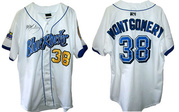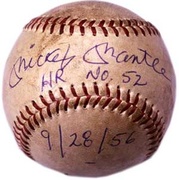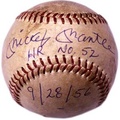
Baseball season is upon us, so naturally our thoughts turn to beer. Yes beer, the social lubricant that transforms even the most taciturn fans into long-lost brothers and sisters—when it isn’t serving as the catalyst for countless post-game brawls in countless parking lots and bars.
“Ruth responded to the writer’s hyperbole by swatting a three-run homer.”
We all have our beer-and-baseball stories, whether it’s the salving effects of a couple of cold ones after your team was literally beat up during an intramural softball game (only one member of our squad was hospitalized, so it could have been worse) or that suds-soaked junket to Arizona to catch a few games of spring training (what happens in Phoenix stays in Phoenix).
One of the best beer-and-baseball stories, though, comes from the dry years of Prohibition, 1920-1933, when the New York Yankees made it to seven World Series and won four. Their rise began in 1915, when the team was purchased for $1.25 million. The new owners were Tillinghast Huston—a civil engineer, who served in the Spanish-American War and World War I and left with the rank of Lt. Colonel—and Jacob Ruppert, Jr.—a wealthy New York City brewer, who served a couple of terms in Congress and enjoyed being addressed by his honorary title, also Colonel. The Yankees had never won a pennant until the Colonels, as they were known, got a hold of them. Their masterstroke was to add a Boston Red Sox pitcher to the roster in 1920. That player’s name was Babe Ruth.

Above: An Associated Press photo of Babe Ruth and Yankees owner Jacob Ruppert, Jr., 1930. Photo via Legendary Auctions. Top: A tin-over-cardboard sign from the late 1930s. Photo by Ken Quaas.
By the time Ruth joined the Yankees, the team had never done better than second place. It didn’t even have its own ballpark until 1923, when Ruppert put $2.4 million of his fortune on the line (he had bought out Huston the previous year) to build Yankee Stadium—up to that point, the Yankees had shared the Polo Grounds with National League rivals the New York Giants.
Ruppert breweriana collector and former advertising exec, Ken Quaas, has been a Yankees fan since he was a kid, which led to his interest in the team’s seminal owner. “I spent the first 35 years of my life living in the New York area,” says the current Chicagoan, who worked in advertising on Madison Avenue for 18 years before moving to the Midwest to become a marketing and communications consultant. “So I grew up a Yankees fan. Mickey Mantle was my hero in the 1960s, Bobby Murcer in the ’70s, and Don Mattingly in the ’80s.”
Jacob Ruppert, Jr. became something of a hero, too, because he made the Yankees The Yankees. Now in his early 50s, Quaas has strong memories of the old Ruppert Brewery on the Upper East Side of Manhattan. “It was in Yorkville, the historically German section of town,” he recalls. “In the mid-1930s, Ruppert expanded his brewery by buying the old Ehret’s Hell Gate Brewery, which was even bigger and virtually around the corner. In the 1990s, after the old brewery buildings were finally torn down in the 1960s, I lived for a while in one of the apartments built on the site.”

In 1935, Jacob Ruppert, Jr. purchased the Hell Gate Brewery in the Yorkville section of the Upper East Side of Manhattan. The building was razed at the end of the 1960s to make way for a residential development. Photo via New-York Historical Society.
The Babe Ruth story began in 1919, when the Colonels, as Huston and Ruppert were known, decided to go after the player they thought would turn their team’s fortunes around. Before he was a Yankee, Ruth had been one the league’s toughest pitchers, winning 24 games in 1917 with a respectable ERA of just 2.01. That year, Ruth also batted .325, which was the sort of average a team wanted more often at the plate than once every four games, the standard rotation to keep pitchers from throwing out their arms. Ruth wanted more at-bats, too. By 1918, Ruth was dividing his time between the pitcher’s mound and the outfield, and in 1919, his transformation from pitcher to fielder was virtually complete—Ruth made 432 trips to the plate in 1919 vs. 123 in 1917, slugging 29 homers vs. just 2.
None of this escaped the attention of Ruppert, who had seen firsthand how much damage Ruth could do as an opposing batter at the Polo Grounds. There, Ruth’s powerful, left-sided swing regularly sent balls sailing over the right-field fence, which, at its shortest distance, was just 256 feet from home plate (by comparison, a ball needed to travel 295 feet at the first Yankee Stadium; the distance at the new Yankee Stadium is 314 feet).
“Ruppert could see Ruth was going to be a star,” says Quaas. Accordingly, in 1919, he dispatched his manager, Miller Huggins, to Boston to meet with Red Sox owner, Harry Frazee, a theatrical impresario who had a habit of selling off Boston ballplayers whenever he was low on cash. Ruth would be Frazee’s biggest payday yet, earning him almost half a million dollars in cash and loans, albeit with Fenway Park as collateral.

This Ruppert Ale tray is from the late 1930s. Photo by Ken Quaas.
The bet on Ruth paid off big for Yankees, while the Red Sox would suffer under what became known as the “Curse of the Bambino” for 86 years (after being the dominant team of the 1910s, they would not win another World Series until 2004). In his first year in Yankee pinstripes, Ruth slammed 54 homers, and in 1921, he hit 59, propelling his team to its first American League Pennant. All without a drop of beer.
“Ruth’s powerful, left-sided swing regularly sent balls sailing over the right-field fence.”
“The year Babe Ruth became a Yankee, Prohibition went into effect,” Quaas says. “Because of that, Ruppert couldn’t advertise or sell his beer at either the Polo Grounds or the first Yankee Stadium until the 1934 season. It’s kind of ironic.” A beer fortune had helped finance the acquisition of Babe Ruth, but with the exception that last Yankee season, when fellow Yankee Lou Gehrig won baseball’s coveted Triple Crown, Babe Ruth’s presence didn’t help Ruppert sell much beer.
Still, Ruth reliably put fans in seats, and Yankee Stadium had 58,000 of them, which earned Ruppert yet another fortune. Before the first pitch had been thrown, sportswriter Fred Lieb of the New York Evening Telegram named Yankee Stadium “The House That Ruth Built,” even though “The House That Beer Built” would have been just as accurate. Ruth responded to the writer’s hyperbole by swatting a three-run homer on opening day against his former Boston teammates (the final score was 4-1). More importantly, that fall, the Yankees faced the Giants in the World Series for the third year in a row, but this time they won, aided by three Ruth home runs, although all were hit at the Polo Grounds. Maybe he was sentimental.

Judge Kenesaw Mountain Landis, baseball’s first Commissioner, and Jacob Ruppert, Jr., in 1922. Photo via Library of Congress.
For Quaas, collecting Yankee and Babe Ruth memorabilia from this era would be nice, but the prices are decidedly major league, and have been for some time. Fortunately, Quaas’s fondness for all things Ruppert, a more affordable passion, is just as sincere. His collection includes beer cans of all sorts, plus Ruppert trays, foam scrapers, and signs, all from the post-Prohibition era.
“I got started when I was about 17 years old,” Quaas says. “I wasn’t even old enough to drink, but there was a store near us that had a lot of different kinds of beer and sold single cans. My dad was good enough to indulge my hobby. It wasn’t like he was a big drinker, or anything, but every time he went to the store he would buy a different brand, drink the beer, and then let me have the can.”
Shortly after that, around the time of the U.S. bicentennial, Quaas had his first and only taste of Ruppert beer. He still has that can, which he describes as “kind of ugly, but very patriotic looking—red, white, and blue. It says ‘Jacob Ruppert Beer’ on it.” According to Quaas, the can lists Orange, New Jersey, as the source of the liquid inside. “It was probably brewed at the old Rheingold plant,” he says. “They did a lot of contract brewing for smaller brands in the late ’70s, usually sold at bargain prices and poorly packaged. My recollection,” he adds, “is it wasn’t very good.”

By the early 1940s, the Knickerbocker brand was elbowing the Ruppert name for prominence. Photo by Ken Quaas.
Quaas expanded beyond cans when he started going to flea markets and garage sales. “I bought some signs and trays,” he recalls of his early collecting years, “then I met a few collectors, older guys, who were real nice to me. One grandfatherly gentleman invited me over his house and gave me a good deal on a bunch of his excess stuff. Then I found out about collector’s organizations and joined them—that’s how I really got into it.”
By then, Ruppert beer was on the verge of being forgotten, but there had been a time when Ruppert beer was on just about every New Yorker’s lips. Before Prohibition, Ruppert made beer in the German style like his father had at the brewery Ruppert, Jr. inherited in 1915, and like his grandfather had back in Bavaria. Ruppert beers ranged from a standard ale to more specialized brews, such as a seasonal bock and a dark beer called Ruppiner.
The most widely known Ruppert brand was a lager called Knickerbocker, which took its name from a character in an 1809 Washington Irving story about an early Dutch New Yorker named Diedrich Knickerbocker, whose costume (tricorn hat, knickers-length trousers) and nickname (“Father” Knickerbocker) became the shorthand caricature of an old-timey New Yorker.

In the 1950s, Knickerbocker was the official beer of the New York Giants, as seen on this beer coaster. Photo via Pinterest.
After Jacob Ruppert, Jr., died in 1939, the Ruppert family held onto the Yankees until 1945, when it focused its attention back on Ruppert Brewing. Not surprisingly, perhaps, the Knickerbocker name became even better known. For example, in 1946, the city’s new basketball team adopted Knickerbocker for its name (although it was almost immediately shortened to Knicks). No doubt Ruppert would have smiled at that, but just as certainly, the Colonel probably rolled over in his grave when, in the 1950s, his Knickerbocker lager was the official beer of the New York Giants, who played at the old Polo Grounds until the end of the 1957 season before moving to San Francisco.
As for the Ruppert Brewery, it closed on December 31, 1965 and was torn down in 1969, making way for the apartment building that Quaas briefly occupied. During the 1970s, Rheingold continued to sell beer under the Ruppert and Knickerbocker brands, but by then, the once-beloved Father Knickerbocker was getting a bit long in the tooth.
“When you look at the Knickerbocker character, he’s an older man, clearly in his 60s, one of those Dutch founding-fathers-of-Manhattan types,” says Quaas. “Not in a million years would something like that appeal to today’s young beer drinker, although the hipsters might have made him popular again, like they did with the Dos Equis ‘most interesting man in the world.’ In general, though, brewers today don’t use old men to sell the image of a youthful, dynamic, and vibrant beer.”

It’s difficult to imagine a character like Father Knickerbocker, seen here in a magazine ad from the 1950s, being used today to sell beer to 21- to 34-year-old men. Photo via Flickr.
These days, given Quaas’s vocation and hobby, he spends a fair amount of his time thinking about such things. “I credit my breweriana hobby with fostering my interest in advertising and the way beers were marketed and differentiated, largely through characters like Father Knickerbocker,” he says, pointing with particular pride to the years he managed the Miller Brewing Company account.
Today, many TV viewers remember with fondness the “tastes great, less filling” ads of the mid-1970s for Miller Lite, which featured famous retired athletes arguing about the virtues of the frosty beverage. Though generally not as old as Father Knickerbocker, these gray-templed former superstars were still a good deal past the highly sought 21- to 34-year-old male demographic their endorsements were designed to lure. Too bad the Babe died in 1948.
“Oh yeah,” Quaas agrees, “had he been around, Babe Ruth would almost certainly have been in those commercials.”
(Special thanks to Ken Quaas for suggesting this story. Images via Legendary Auctions, New-York Historical Society, Library of Congress, Pinterest, and Flickr.)

 How To Build a Killer Baseball Collection: Scouting the Minors With Dave Bloomer
How To Build a Killer Baseball Collection: Scouting the Minors With Dave Bloomer
 Boston vs New York: Appraiser Leila Dunbar Talks Sports Memorabilia and Rivalries
Boston vs New York: Appraiser Leila Dunbar Talks Sports Memorabilia and Rivalries How To Build a Killer Baseball Collection: Scouting the Minors With Dave Bloomer
How To Build a Killer Baseball Collection: Scouting the Minors With Dave Bloomer Now Batting, National Baseball Hall of Fame Curator Tom Shieber
Now Batting, National Baseball Hall of Fame Curator Tom Shieber Babe Ruth MemorabiliaThere is little question that George Herman “Babe” Ruth was one of the grea…
Babe Ruth MemorabiliaThere is little question that George Herman “Babe” Ruth was one of the grea… BrewerianaBreweriana spans a wide range of items having to do with beer and brewing. …
BrewerianaBreweriana spans a wide range of items having to do with beer and brewing. … Mari Tepper: Laying it on the Line
Mari Tepper: Laying it on the Line Nice Ice: Valerie Hammond on the Genteel Charm of Vintage Canadian Costume Jewelry
Nice Ice: Valerie Hammond on the Genteel Charm of Vintage Canadian Costume Jewelry How Jim Heimann Got Crazy for California Architecture
How Jim Heimann Got Crazy for California Architecture Modernist Man: Jock Peters May Be the Most Influential Architect You've Never Heard Of
Modernist Man: Jock Peters May Be the Most Influential Architect You've Never Heard Of Meet Cute: Were Kokeshi Dolls the Models for Hello Kitty, Pokemon, and Be@rbrick?
Meet Cute: Were Kokeshi Dolls the Models for Hello Kitty, Pokemon, and Be@rbrick? When the King of Comedy Posters Set His Surreal Sights on the World of Rock 'n' Roll
When the King of Comedy Posters Set His Surreal Sights on the World of Rock 'n' Roll How One Artist Makes New Art From Old Coloring Books and Found Photos
How One Artist Makes New Art From Old Coloring Books and Found Photos Say Cheese! How Bad Photography Has Changed Our Definition of Good Pictures
Say Cheese! How Bad Photography Has Changed Our Definition of Good Pictures Middle Earthenware: One Family's Quest to Reclaim Its Place in British Pottery History
Middle Earthenware: One Family's Quest to Reclaim Its Place in British Pottery History Fancy Fowl: How an Evil Sea Captain and a Beloved Queen Made the World Crave KFC
Fancy Fowl: How an Evil Sea Captain and a Beloved Queen Made the World Crave KFC
And here’s a bit of Father Knickerbocker on the local New York TV show that would be the lineal progenitor of the Tonight Show … with Steve Allen: https://archive.org/details/TheSteveAllenShow30december1953